As an Amazon Associate I earn from qualifying purchases.
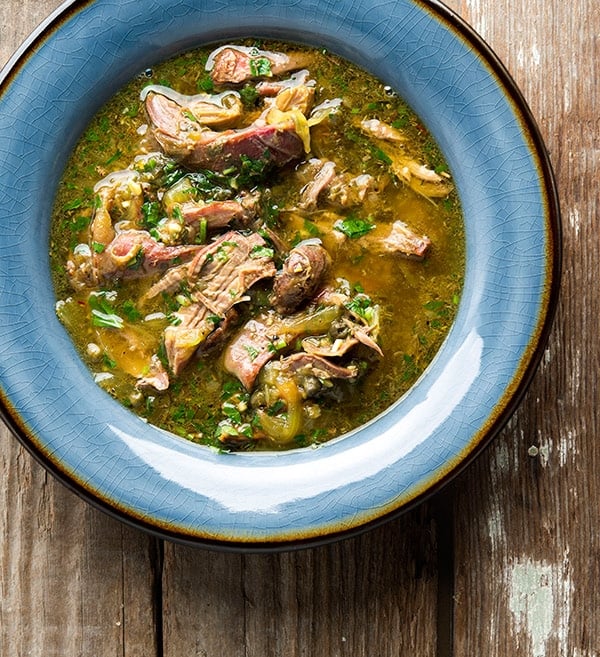
There’s a reason few people eat jackrabbits in this country: For many, they are indelibly stained as poverty food, a meat of the Depression or the even harsher privations of the pioneer farmers who eked out a living on the sod of the Great Plains.
What’s more, non-hunters cannot buy jackrabbits, which unlike their cousins the true rabbits, will not cotton to domestication. And most hunters, who see these giant rabbits everywhere, rarely shoot them: Their minds are filled with cloudy notions about parasites, diseases and foul-tasting meat.
This is a pity, because jackrabbits are nothing more than American hares. Not a true rabbit, most hares have dark meat whose color falls somewhere between duck and beef. Hares live longer and are smarter than rabbits, and give birth to young that can hop away at a moment’s notice; rabbit younglings are pink and helpless.
Holly and I shoot hares, mostly black-tailed jackrabbits, whenever we get the chance. We do this for several reasons, mostly because they are gamey and delicious. Hares are more highly regarded in Europe, and I have many recipes for them from countries as disparate as Sweden and Sardinia.
That’s where my most recent hare stew came from.
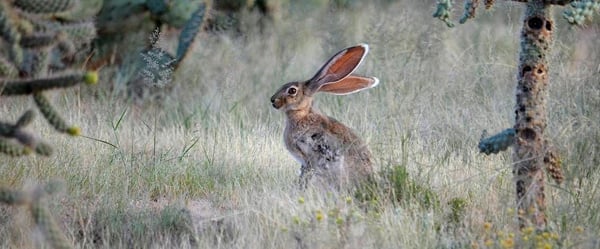
I developed my recipe for a Sardinian hare stew from a rabbit dish called coniglio al guazzetto that I found in Giuliano Bugialli’s book Foods of Sicily & Sardinia and the Smaller Islands. It is unusual in that it uses capers as a major flavoring component. The other dominant flavors are saffron, which grows on the island, and red wine vinegar. It is a heady dish, great for cold weather.
If you cannot get hare, which is likely I am sorry to say (although you can buy real Scottish hare from D’Artagnan), I would substitute lamb first; that just seems more Sardinian to me. You could also go with rabbit or chicken, but make sure the chicken is as old as you can find — look for a stewing hen in Asian or Mexican markets.
How did jackrabbits and hares get to be so stigmatized? Part of the reason is because those cloudy notions wafting through hunters’ heads have an element of truth to them.
Jackrabbits, like all rabbits in this part of the world, can carry a disease call tularemia, which is no fun. You can tell by looking at the liver: If it is streaky with white marks, it may be infected. The meat will be fine, however, so long as you braise it well. Always wear gloves when butchering wild rabbits and hares in the West and you will be fine.
There is another unusual thing about the meat of jackrabbits — it lacks a certain protein (or amino acid, I can’t remember) that most other meats do, so if you eat nothing but jackrabbits, as many Great Plains pioneers did, you will actually develop malnutrition; it’s a little like contracting pellagra from eating too much corn. Once our ancestors realized this fact, they banished jackrabbits from their diet. Tossing the bunny out with the bath water, I’d say.
I would like to make the case for reintroducing hares to the American diet.
For starters, jacks are abundant — and there is no closed season on them in many states. That means you can shoot as many as you will eat, whenever you feel like it. And they freeze well. You should know that jackrabbits in hot weather are not nearly so tasty as those in the fall (the ones I used for the hare stew were shot in a pear orchard in September), and summer jacks can sometimes be attacked by botfly, which leaves icky sores on the hare’s back but does not normally affect the meat; botflies also affect other game animals, but the flies are usually gone by the time hunting season rolls around.
Another reason to eat more jackrabbits and hares is because they are big. Really big. One black-tailed jackrabbit can feed four easily, and Holly and I got four meals out of two jackrabbit forelegs plus four hind legs.
Still another pleasure of eating hares is their flavor. The dark meat is undeniably gamey, with an indescribable aroma and flavor that screams “wild.” It is not for everyone: One allegedly epicurean judge on Iron Chef turned her nose up at the wild hare she was served in “Battle Rabbit.” Keep in mind that snowshoe hares are very different — they are lighter in color and far milder, more like rabbit, actually. I like the lustiness of jackrabbit, however, especially with other strong flavors like the capers and saffron in the hare stew. A little goes a long way.
Which is probably the best reason why eating more jackrabbits and hares is a good idea in these tough economic times. Like I said, we got many meals out of a little more than one hare. The reason is because the meat is so flavorful you can plunk a dollop of stew on a bowl of polenta, or couscous, or rice, and be perfectly happy. We ate most of a loaf of bread when we first sat down to eat this stew. The only domestic animal I can think of that even comes close to the depth of flavor of a wild hare is an old chicken.
Eating this way brought me back to my old days as a graduate student and cub reporter. I was poor, and needed to make meat stretch. I developed an eating technique that made sure I got some sauce and a little bit of meat with every large spoonful of grain. I always left the choicest piece of meat for the last bite. It was — and is — a gratifying way to eat. It felt like I was satisfying my Champagne tastes on a Budweiser budget.
And that’s a good thing these days.
Sardinian Hare Stew
Ingredients
- 1-2 hares or rabbits
- 4 tablespoons olive oil
- 1/2 cup chopped parsley, plus another 1/4 cup for garnish
- 5 cloves garlic, chopped
- 1 large onion, chopped
- 1/4 cup capers
- Large pinch saffron
- 1 cup warm water, to bloom saffron
- 1/4 cup high-quality red wine vinegar
- Salt
Instructions
- Salt the hare or rabbit pieces well and set aside at room temperature for 30 minutes.
- Get the olive oil hot over medium-high heat in a large pot or Dutch oven. Pat the hare pieces dry and brown well in the pot. You might need to turn the heat down to medium. Do it in batches and take your time. Place the browned pieces in a bowl while you do the others. This could take 30 minutes.
- Meanwhile, chop half the capers. Get your tap water running as hot as it will go and fill a cup measure. Crush the saffron in your palm and sprinkle it into the hot water. Get every bit, and let this soak as the hare is browning.
- Once the meat is all browned, remove it to a bowl. Add the onion and saute until browned. Add the garlic and cook for 1-2 minutes.
- Add everything into the pot except the extra 1/4 cup parsley, nestling the hare pieces in tight. If the liquid does not come at least halfway up the sides of the hare pieces, add some more water. Do not add wine or stock — the point is to have pure flavors here. Cover tightly and simmer gently over low heat for at least 90 minutes. Hare needs longer, but chicken and domestic rabbit should be done by then. Check the hare after 2 1/2 hours; it should be close to falling off the bone. When it is, pull the meat out and strip it from the bone.
- Return it to the pot with the extra parsley and mix well. Turn off the heat and cover for five minutes. Serve over polenta, couscous, Sardinian fregula pasta or with crusty bread. Don’t forget the wine: You will want a big, heavy red here.
Nutrition
Nutrition information is automatically calculated, so should only be used as an approximation.

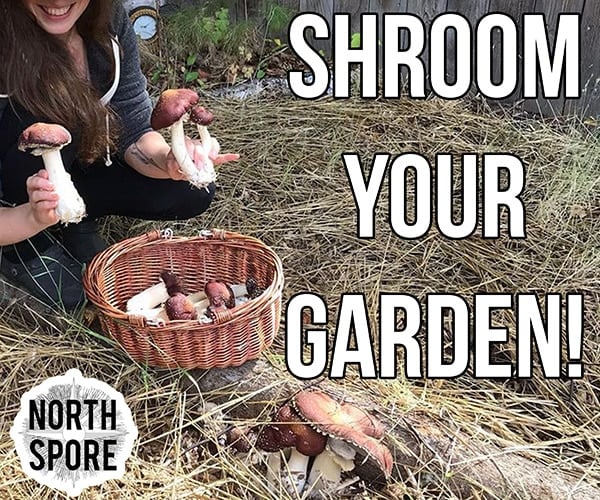
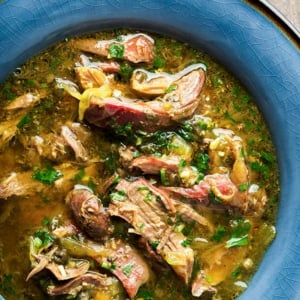

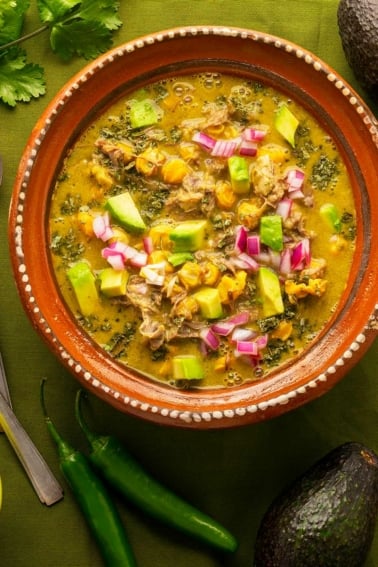

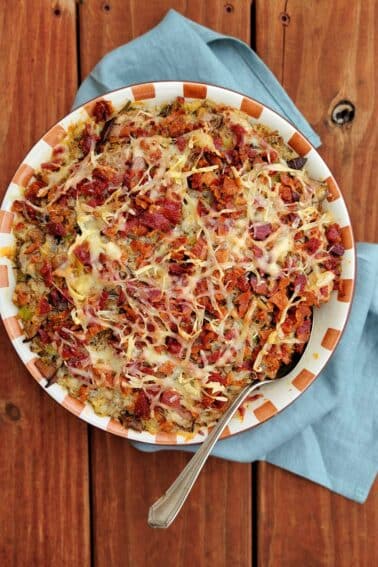
Great recipe.
I had a tough old rooster that, unfortunately, I needed to put down. I decided to try this recipe having tried jack rabbit many years ago and knowing how tough they are.
Fantastic! This is a keeper for us.
Interesting with the acidity notes. It reminds me of hasenpfeffer to some extent although much milder.
I want to make this for my family. My wife is a pescatarian usually I will just sub fish for her in meat-based meals. do you think a whitefish could be good in this for her plate?
I have four pheasants in the fridge from a hunt today. It seems to me that they would be well suited for this recipe!
I’ll give it a go and report back!
Ended up very tasty with pheasant! Makes a great broth… Thank you!
Made this today with old gobbler thighs, slow simmer all afternoon to achieve tenderness. Anything involving a caper is a winner in my book. Interesting acidity, was great with sourdough ciabatta. Will try this with rabbit in the future.
Hi Hank,
Is there any place that I could buy Hare online or around the SF bay area?
Kim: Yes, look up D’Artagnan. They sell Scottish hare online.
Made this tonight with a hare we got at the weekend – bloody delicious! The capers go so well with the meat, as does crusty bread for mopping up the juices!
Hank, all your recipes that I have tried are outstanding. But this one is out of the park. I shared it with some friends yesterday. They raved over it. So I asked when they wanted me to make it again. The answer was “tomorrow.” LOL Thanks for sharing such wonderful recipes!
Thank you for explaining the myth about Jack Rabbits . Especially how the Black Tailed Jack Rabbit is in fact a HAIR ! I all ways suspected this ! I remember reading about English Kings having ” Jugged Hair ” prepared for them . I mean Hay ! If Kings liked it ? It must be tasty ! But then I also read about hanging Hairs and Pheasant for several days without gutting them out ? What was this all about ?
Corn was once only fed to pigs in France. Shark was once a worthless fish who’s tail was cubed to pass as bay scallops in soup. Lobster was only fit for prisoners. There are so many more examples of “trash” foods now considered delicacies.
Thank you for helping black tailed jack rabbit find a place on the dinner table. I tell people that deer, elk, antelope and jack rabbit of course are gamy. Cow and pig are gamy. But we grew up eating those proteins.
So please, don’t overcook your game fearing parasites until it’s no tastier than the coals it was used to cook it with!
By far, my favorite jackrabbit recipe.
So I made this yesterday with a hare I shot in April. It was a big beast and I got 2 haunches, 2 backstraps and 1 foreleg from it. I put the rack of ribs in the oven and slow cooked with some seasaoning – hare ribs.
The actual recipe has grown on me as at first I was unsure what I was tasting but second day its flavour matured and mellowed and so I will probably shoot the next hare I see and do this again or even make one of the other recipes. The hare is OK.
This recipe is astoundingly good! My brother and I just gave the parents and my brother’s girlfriend an introduction to wild game. We had venison backstrap and this Sardinian Hare Stew. I will admit, I was a little nervous about eating a jackrabbit but this stew made me a believer. Everybody in the family loved it! The only thing I changed was I swapped the 2.5hr of simmering for 50min in a pressure cooker, but that was due to time constraints. It was literally falling off the bone.
I tried this with some jackrabbit from this past winter. I’m not used to conducting “big” recipes, but this was simpler than I expected and I liked it a lot. I’ve never eaten the flavors of saffron or capers, but they were interesting and delightful. Thanks for the recipe!
Ran out of squirrel meat and don’t know I’ll be able to find any local rabbits around here. If I use chicken, how much and what cut would you recommend?
Abbie: Use chicken thighs.
Sir would this stew be good with squirrel?
Matthew: Absolutely.
Hi Hank, I’ve been using a lot of your hare recipes for jack’s harvested locally down here in southern az, and they’ve been great! I was contempting of modifying this recipe with canned nopalitos vs. the capers, and adding a bit of heat to make something a little more southwest. Was curious your thoughts on it? Thanks again for sharing all of your work and research, and hope to hear your thoughts*
Clint: Both good ideas, but I’d suggest getting your hands on cholla buds. You can buy them from the Tohono O’Odham or online. They’re a great addition.
Thanks for this great recipe. Have you tried it in a crockpot? Wondering how long it would take.
Thanks, Lauri
Lauri: I haven’t, but if I had to guess I’d say 6 to 8 hours.
I cooked this recipe in the crock pot on low for 6 hours. Turned out awesome! The whole family loved it. I added about a cup and half more of water. The recipe was made with snowshoe hare. No jackrabbits in my neck of the woods (Québec, Canada). Big fan of all your recipes Hank! Cheers
Thanks for the recipe, Hank. I’ve been enjoying jackrabbits for a couple of years – but only on the grill. This stew will become a staple. We tried it with a Pinot noir and a Sauvignon blanc. For what it’s worth, I preferred the white over the red though both worked well.
I recently harvest a wild boar as well. Tomorrow night I’ll attempt your Osso Bucco recipe with the shanks.
Anyone try this in a pressure cooker yet? It sounds heavenly and we are looking forward to giving it a try but I thought the pressure cooker might be a great way to cut down on cook time. Mine’s not electric, so we could even take it camping!
Thank you so much for this incredible recipe! I first tested it out using chicken thighs and the wife loved it. I just now made it with wild rabbit and fresh garlic from the garden. The only thing I did different is add celery.
I’m thrilled to have this recipe and that it’s such a hit. This is the BEST way I’ve ever had rabbit.
Thanks Mr Shaw!